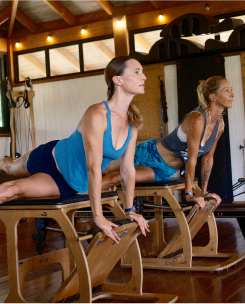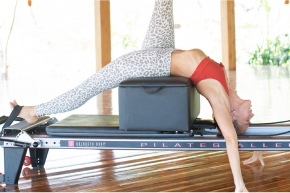Pilates for Osteoporosis: All You Should Know

Pilates can help you improve your muscle strength and maintain bone strength and balance. It also helps with posture and pain and proves to be very beneficial for osteoporosis. With osteoporosis affecting millions of people globally, it is vital that you prioritize your bone health and take steps to maintain healthy and strong bones throughout your life.
In this blog, we are going to talk about the ways in which Pilates can help bone health. We are also providing tips for effective and safe practice. Whether you are just starting out or a seasoned Pilates practitioner, read on to explore the benefits of Pilates exercises for osteoporosis.
Can You Do Pilates For Osteoporosis?
Generally, Pilates is very safe and won’t result in any bone damage. However, to be on the safer side, we suggest you use alternative moves that allow you to bend in a comfortable and controlled position. This is going to help you cut down the risk of injuring your back. The experts at Pilates Nosara are great at what they do, they keep your conditions in mind and train you to be stronger and a better version of yourself.
Is Pilates Safe For Osteoporosis?
Willing to perform Pilates exercises but are afraid of doing so because of your osteoporosis? Then, you would be glad to know that experts at Pilates Nosara highly recommend Pilates exercises for osteoporosis. These help to improve mobility, strength, balance, and bone density. Moreover, you must also consult your practitioner on which Pilates exercises to avoid with osteoporosis. In general, any exercise that targets the spine, hip, and wrist might be invaluable for the condition. Here are some common ones that prove to be beneficial:
- Exercises on plank and on fours are great for full-body conditioning, as well as wrist strengthening
- Back strengthening and extension exercises might assist with mobility and posture, but they are not recommended for spondylosis and stenosis.
- Side Leg Series and Bridge exercises focus on alignment, core strength, and balance while strengthening the muscles around your hip.
- Standing Pilates, balance-enhancing, and foot-strengthening exercises aid with the prevention of falls.
Adding resistance to bodyweight exercises could help elevate the load and improve bone strength. This might include using a reformer, tower, chair, or resistance bands. Ask your practitioner about how you can get help with Pilates for osteoporosis.
How Is Pilates Good For Osteoporosis?
Increasing Bone Density
If you are wondering, “Is Pilates good for bone density?” then the answer is none other than yes. Mat and reformer pilates can support bone health by increasing bone density through weight-bearing movements. There is much evidence suggesting that resistance training and direct loading of the bones help increase bone density.
Exercises, including squats, lunges, and planks, apply controlled stress to the bones, maintaining bone mass and helping stimulate growth. The reformer machine also gives more adjustable resistance, which is especially helpful for those requiring more support or challenge. At Pilates Nosara, the experts will guide you on what exercises would be most beneficial for your health, whether you join on-site or online.
Improving Posture and Alignment
Pilates also improves spinal alignment and posture. Bad posture puts unnecessary strain on joints and bones. It just adds more to injury and discomfort over time. Pilates strengthens the muscles that support your spine and motivates proper movement patterns, reducing the risk of postural strain and back pain. It supports spinal health, which is vital for those preventing or managing osteoporosis.
Enhancing Balance and Reducing Falls
Improved coordination and balance are among the lesser-known yet promising benefits of Pilates, particularly for older adults. By strengthening and stabilizing muscles and improving body awareness, Pilates reduces the likelihood of falls and trips, which are a huge reason behind fractures in those with low bone density.
How Often Should You Do Pilates For Osteoporosis?
Even doing Pilates once a week can give meaningful improvements in stability, posture, and muscle tone. However, the perks of Pilates once a week might be more gradual compared to those in people who attend more frequently. You can get better results, particularly for bone health, by performing reformer Pilates 3 times a week. This promises noticeable enhancements in flexibility, bone strength, and functional movement.
For individuals exploring alternative styles, the benefits of Pilates performed in a heated room promise improved circulation and flexibility, though it might not offer the same weight-bearing capabilities as a reformer or mat Pilates.
Conclusion
Whether you are a young adult striving to build bone mass or an older adult looking to stop the progression of your osteoporosis, Pilates is your best bet. Pilates for osteoporosis is a highly effective and low-impact manner to improve your bone health. With regular practice, it helps improve posture and bone density and reduce any risks of injury. With the support of a certified instructor, you will get mental and physical benefits at any stage of age. So, hurry up and book your session at Pilates Nosara right now!
Related Resources

A Thousand Different Bodies In A Lifetime
A thousand different bodies in a lifetime. A teacher in training once said that she has learned so much through her thousand different…

Pilates Training Benefits for Climbing
Conquer Your Limits with Pilates: Jenni’s Journey to Climbing Mount

My Top 5 Things To Do In Nosara
Are you wondering how to plan the perfect trip to Nosara? Scroll down to see my list






